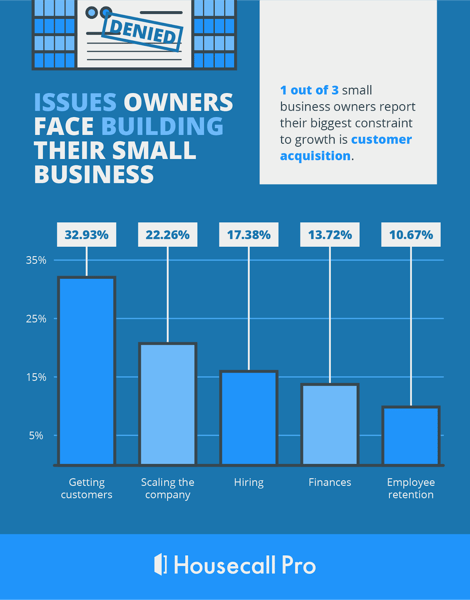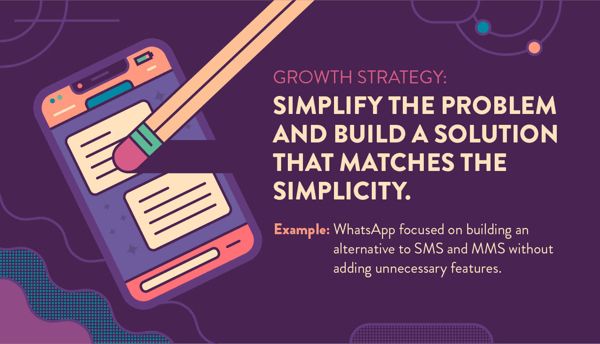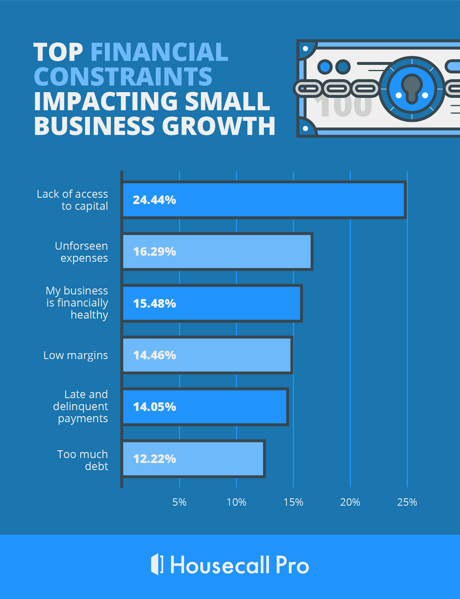December 17, 2019
 by Scott Turner / December 17, 2019
by Scott Turner / December 17, 2019

Starting a small business might seem like a step in the right direction, but there are growing pains prospective small business owners need to consider.
All small businesses strive to be profitable, but studies show that about half of all small businesses fail in the first five years, and only 20% survive the next five.
Seeing these stats made us think – what's the difference between those that succeed and those that fail? Are there commonalities for both those that thrive and those that don’t?
In order to better understand this, we recently surveyed over 300 small businesses to learn more about the challenges they face when trying to grow their businesses.
We found several distinct trends:

Note: All statistics below come from Housecall Pro's small business survey.
Though there are other strategies for growth, nothing beats a revenue increase from new customers. 33% of the small businesses we surveyed said this was their biggest struggle
Twenty-three percent of small businesses see scaling internal processes and systems as a big concern when it comes to growth.
Only about 14% of those we surveyed said that they had not seen any issues with hiring and nearly 11% of said they have had trouble keeping the talent they have hired.
| RELATED: Read more on how to attract and retain top talent so you can find more success in your recruitment strategies. |
4. Access to capital is a major concern
Nearly 25% small businesses we surveyed specifically mentioned that access to capital was their number one financial concern, with a lack of reserves at number 2 (16%). Only 15% of those we surveyed reported that they felt they were financially healthy.
A common reason why small businesses struggle to grow is that they get caught up in “tactical hell.” They read an article that tells them “do Facebook ads!” or “write a blog!” and immediately spend money on these tactics thinking it will help them grow, only to find it’s not working months later.
That’s because the tactics they’re pursuing are missing the right strategy behind them.
For example, a blog only works if your ideal customers are looking for information online and you’re actually writing about those things. Similarly, Facebook ads only work if your ideal customers are on Facebook and your ads are written in such a way that connects with them.
That’s why a real growth strategy always starts with understanding the customer – their needs/wants, thoughts/beliefs, and problems/situation.
Take WhatsApp for example:

Courtesy of CleverTap
Their growth strategy was simple: focus on what their users really wanted, and cut out all the excess they didn’t. And they’ve become one of the largest messaging platforms in the world as a result.
The same is true for your business: the better you understand what your customers really want, the more effective tactics like blog posts, ads, and even your services/products become at helping you grow.
Let's dive into the best strategies for overcoming the growing pains that inevitably come with small business ownership.
Most businesses struggle to acquire customers because for one of two reasons: they aren’t solving a real problem their customers have, and they aren’t speaking to those problems the right way.
Customers have to actually need what you’re offering first and foremost. If they don’t, it doesn’t matter how great your product/service is – they’re not going to buy. Then you have to get them to see that they need it (i.e. your messaging and marketing).
The good news is, if you’re struggling to acquire customers for either reason, there’s a simple fix for both: go talk to them.
It has been said that there is more information in a single customer’s head than you could ever hope to implement in your business. So asking just a few of your existing customers questions like these below can help you better understand how to shape your products/services and your messaging so that they match what they care about:
| “What did you like about working with us?” |
| “What could we have done better?” |
| “What do you wish a [YOUR INDUSTRY] would do that no one is doing?” |
| “Tell me more about how you found us…” |
Once you’ve collected the data, it’s simply a matter of applying what you’ve learned across marketing channels and to your products and services. Rinse and repeat regularly to drive additional growth.
Your internal processes, systems, technology, and people are the skeleton of the machine that is your business. And as you grow, this skeleton will have to grow with you. Unfortunately, there isn’t a universal best way to do this. No two businesses are 100% alike and what works for one may not work for another.
However, here are a few things you should keep in mind that will help you do this well:
|
With unemployment at record lows, recruiting has become extremely difficult. The good news is there are still ways to draw top talent to your business regardless of how difficult the market is. And it starts in the same place that your customer acquisition strategy does: understanding what talented people care about and shaping your workplace and recruiting process accordingly.
Some of this will have to do with the industry that you’re in. But there are a few specific things I’ve seen come up regularly (as someone who has worked in recruiting for several years) that will help you regardless of industry:
|
Demonstrating these to both your current and prospective employees will help you hire and retain them. This starts with your job descriptions/postings and includes everything from the way you interview all the way to the way you onboard them and help them thrive.
Candidate experience and skill development are critical, especially in this competitive talent marketplace!
|
TIP: Many companies rely on a combination of personalized experiences and recruiting software to make the candidate experience memorable in the best ways. See how recruiting software can help you achieve the same levels of success! |
In addition to struggling to acquire customers, many small businesses make a costly mistake that leaves them short on capital and customers; they compete on price instead of value.
There will always be someone willing to do it cheaper. And if you try to compete with them using lower prices, pretty soon, it becomes impossible to run your business because you’re not making any money.
😂When your client asks if you can do it cheaper pic.twitter.com/TJSv1PwhQu
— Larry Kim (@larrykim) April 11, 2019
So instead of joining the race to the bottom, focus on maximizing the amount of value you can offer your customers, and highlight that in your marketing and offerings. The more you do that, the more they’ll be willing to pay.
At a high level, it’s the same as your customer acquisition strategy above. Learn what they care about and shape what you do and how you talk about it around that.
However, keep in mind:
And remember: the market will always speak loudest. If you’re asking for more than the market will tolerate, you may need to regroup.
While additional cash flow will solve many financial issues, a large percentage of the businesses we surveyed mentioned that accounting and finance related obstacles (like debt, delinquent payments, and unforeseen expenses) were also a big challenge.

This is where the right piece of software or even a part-time small business accountant can help you better manage your money so you’re prepared for the unexpected.
Sites like Paro.io offer “freelance” CFO services. Other sites like Upwork will give you access to thousands of accountants at a variety of price ranges.
Most of these common growing pains can be addressed with one thing: talking to your customers and employees. Find out what they’re struggling with, what they aspire to achieve, and how you can help. Then use this information to shape every aspect of your business.
Need more tips on successfully starting and scaling your small business? Check out G2's small business hub, with over 30 useful resources to keep you on track.
Scott helps entrepreneurs and small business owners use their expertise to drive sales conversations with content. When he’s not laboring over the perfect headline, you’ll find him surfing, diving, or searching for the best tacos in San Diego.
If you’re running a small business, chances are you grapple with low productivity from time to...
 by Taru Bhargava
by Taru Bhargava
If you own a small business, you know how difficult it is to get everything up and running...
 by Ashley Spencer
by Ashley Spencer
As a small business owner, financial planning can feel overwhelming.
 by Joanne Camarce
by Joanne Camarce
If you’re running a small business, chances are you grapple with low productivity from time to...
 by Taru Bhargava
by Taru Bhargava
If you own a small business, you know how difficult it is to get everything up and running...
 by Ashley Spencer
by Ashley Spencer


